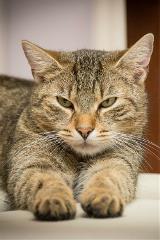FLUTD: Clinical Signs and Treatment

Feline Lower Urinary Tract Disease (FLUTD)
Conditions of Feline Lower Urinary Tract Disease (FLUTD) affect the urinary bladder and the urethra. Recognizing the clinical signs may help to identify the underlying cause of the animal’s condition in order to determine a proper course of treatment.
Clinical Signs
The common signs and symptoms of FLUTD include:
- Dysuria
- Straining to urinate
- Stranguria
- Painful urination exhibited by crying
- Pollakiuria
- Increased frequency of urination
- Caused when bladder and urethra become infected and inflamed
- Increased frequency of urination
- Hematuria
- Blood in the urine:
- Occurs with infection and inflammation
- May be visible by red discoloration
- May only be detectable through a urine test
- Blood in the urine:
- Periuria
- Urinating outside of the litter box
- Occurs when irritated and inflamed bladder creates an urgency to urinate
- Urinating outside of the litter box
- Additional behavioral changes
- Excessive grooming
- Pain may cause cat to over groom area of perineum
- Some cats will present with loss of hair
- Temperament changes
- Pain may cause animal to act or react aggressively or as if irritated
- Pain may cause animal to act timid and hide
- Excessive grooming
Cause
The underlying causes of FLUTD may include:
- Urolithiasis
- As in humans, cats can also develop bladder stones
- It is estimated that 10 to 15% of all cases of FLUTD involve urolithiasis
- Magnesium ammonium phosphate (struvite) and calcium oxalate make up the majority of the cases of urolithiasis
- Urethral obstruction
- May occur In male cats
- Caused by the accumulation of debris found in the urine, possible contaminants include:
- Proteins
- Cells
- Crystals
- Additional causes of urethral obstruction may include:
- Small bladder stones that become lodged
- Severe muscle spasms occurring in an inflamed and irritated urethra
- Bacterial infections
- Bacterial cystitis
- Occurs less frequently in cats than in other animals
- When diagnosed in cats, the animal tends to be older
- Bacterial cystitis
- Anatomical defects
- Stricture affecting the urethra that restricts the urine flow
- Damage caused to the urethra creating the development of fibrous tissues
- Neoplasia
- Not as common in cats, but cancer of the bladder or urethra is possible
Diagnostic Tests
Methods that aid in the determination of the underlying cause of urinary tract conditions include:
- Imaging
- Ultrasound
- Bladder stones
- Thickening of the bladder wall
- Radiographs
- Identify radiopaque stones in the urinary bladder
- Provide contrast studies to determine:
- Structure of the urethra
- Thickened, irregular bladder wall
- Anatomic defect
- Presence of tumor involving the urinary bladder
- Ultrasound
- Urinalysis
- Testing of urine sample will include:
- Bacterial culture, blood, and sensitivity test to check for urinary tract infection
- Results can be variable, but may indicate presence of:
- Crystals
- Blood
- Bacteria
- Testing of urine sample will include:
- Blood tests
- Tests to provide information regarding the animal’s overall health, will include:
- Serum biochemistry panel
- Complete blood count
- Thyroid hormone assay
- Tests to provide information regarding the animal’s overall health, will include:
- Biopsy
- Tissue sample if tumor is suspected
Idiopathic FLUTD
It is estimated that of all of the animals that show symptoms of FLUTD, 60 to 70% will show no specific underlying disease. Termed idiopathic FLUTD (iFLUTD), these animals are viewed in two categories:
- Obstructive iFLUTD
- Occurs when the urine flow is obstructed
- Non-obstructive iFLUTD
- Occurs when the urine flow is maintained
- Found in males and females of all ages, but seldom in animals less than one year or greater than ten years of age
- In males, non-obstructive iFLUTD typically precedes obstructive iFLUTD
- Result of blood tests in non-obstructive iFLUTD is typically normal
Combining the clinical signs with the diagnostic test results will often point to an underlying cause of a lower urinary tract infection. However, FLUTD does not refer to one specific disease which makes the determination for a treatment plan difficult, especially when the exact cause of the condition remains unknown.
Want to learn more?
Please join us for a Free Webinar presented by Covetrus and Purina to learn more about the ways therapeutic diets can support the urinary tract health of cats and dogs!
Free Webinar: The Nutritional Management of Canine and Feline Urinary Conditions
Thu, Mar 10, 2016 2:00 PM - 3:00 PM EST
Presented by Steven R. Cohn, DVM, Veterinary Communications Manager, Nestlé Purina PetCare Company
Webinar attendees will earn 1.0 hour of CE credit - REGISTER NOW
Sources:
http://icatcare.org/advice/feline-lower-urinary-tract-disease-flutd
Careers
Are you looking for a place to let your talents shine? At Covetrus, we help our practitioner customers better serve their patients and take pride in providing the best customer experience possible. Search our open positions to see our available opportunities.
Newsletter
Stay current with what’s going on with Covetrus, subscribe to receive our newsletter and email communications. Subscribers will receive the latest information in practice management, sales and marketing, animal health, and more.


Leave a comment